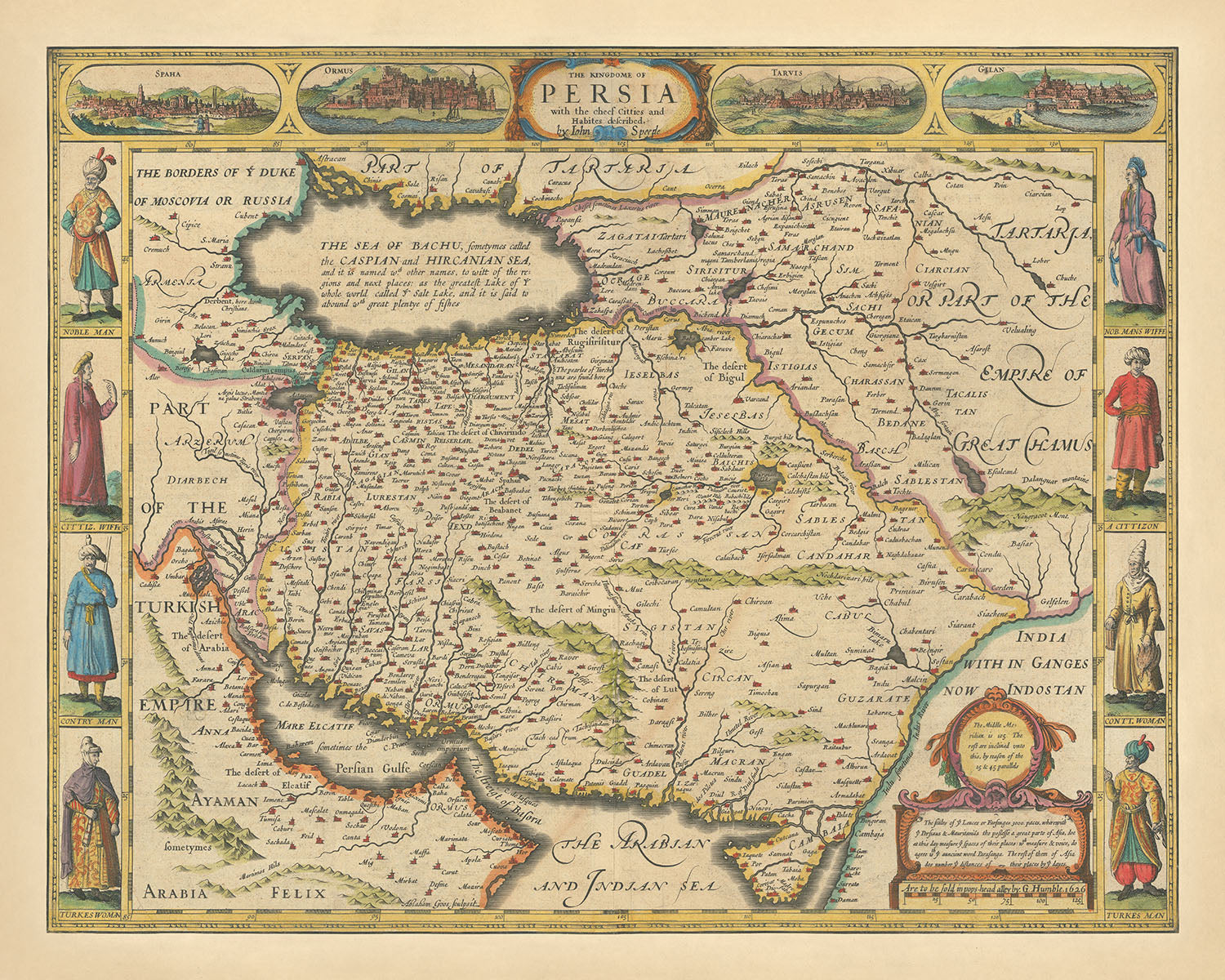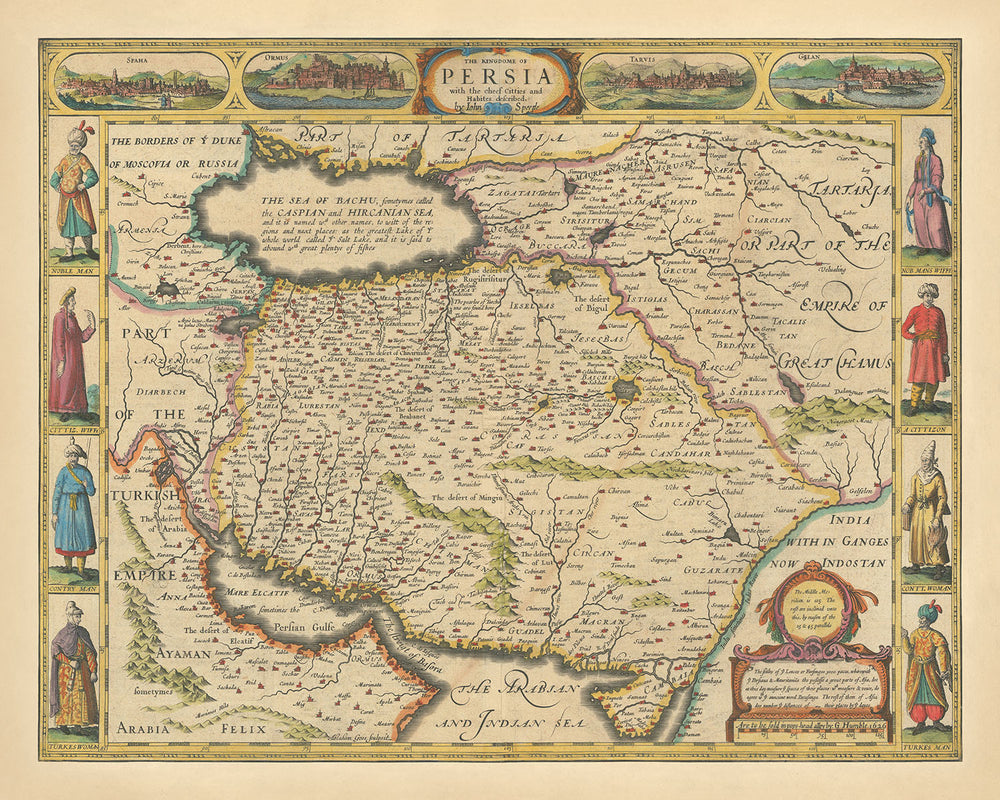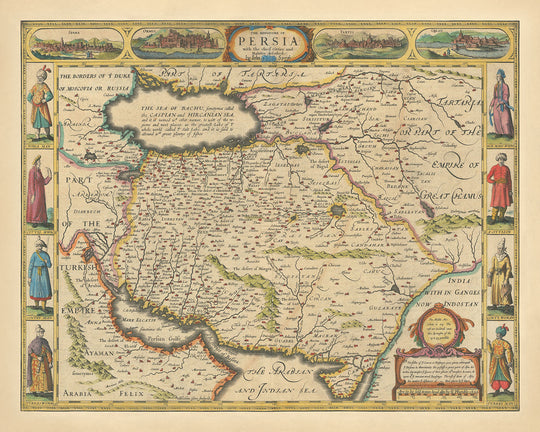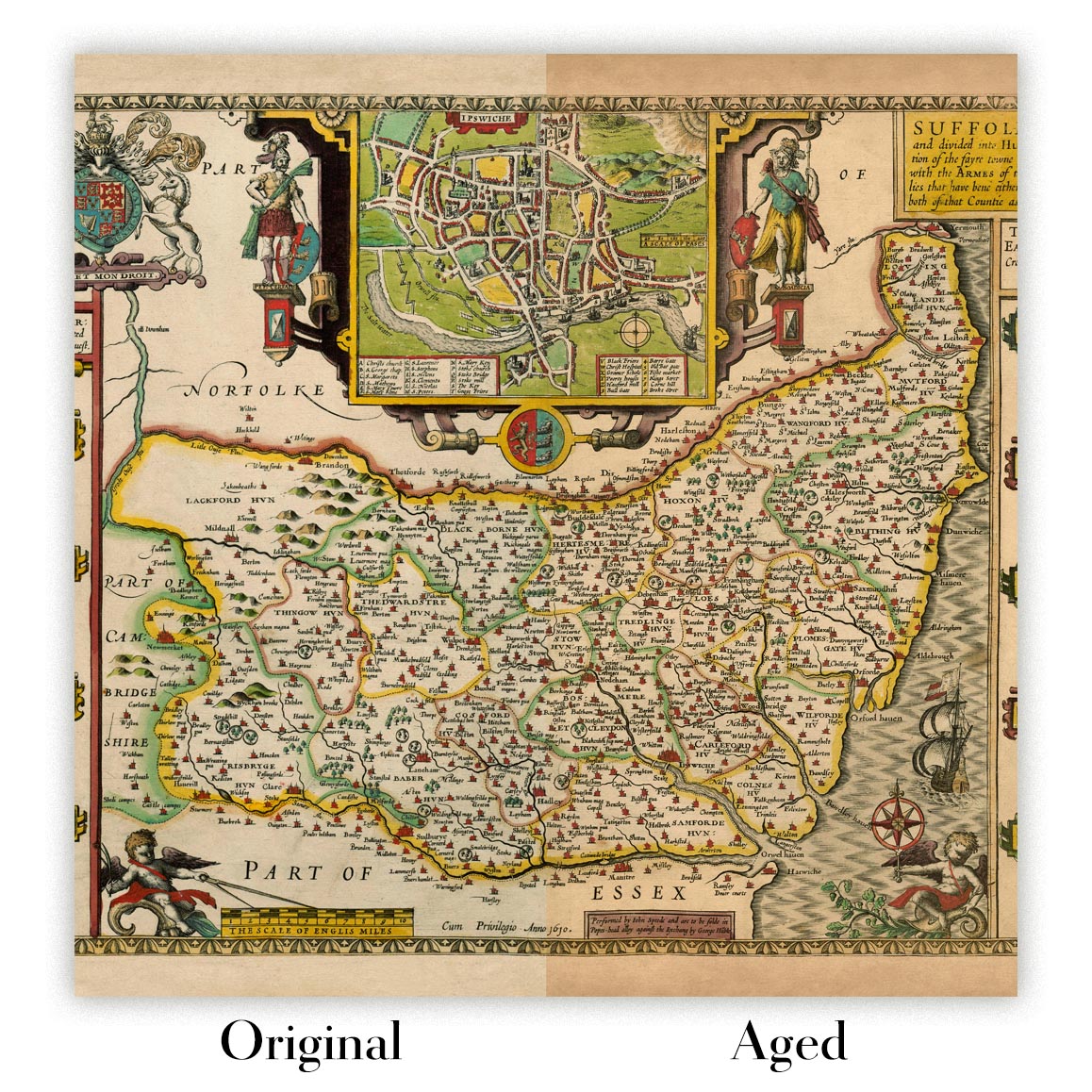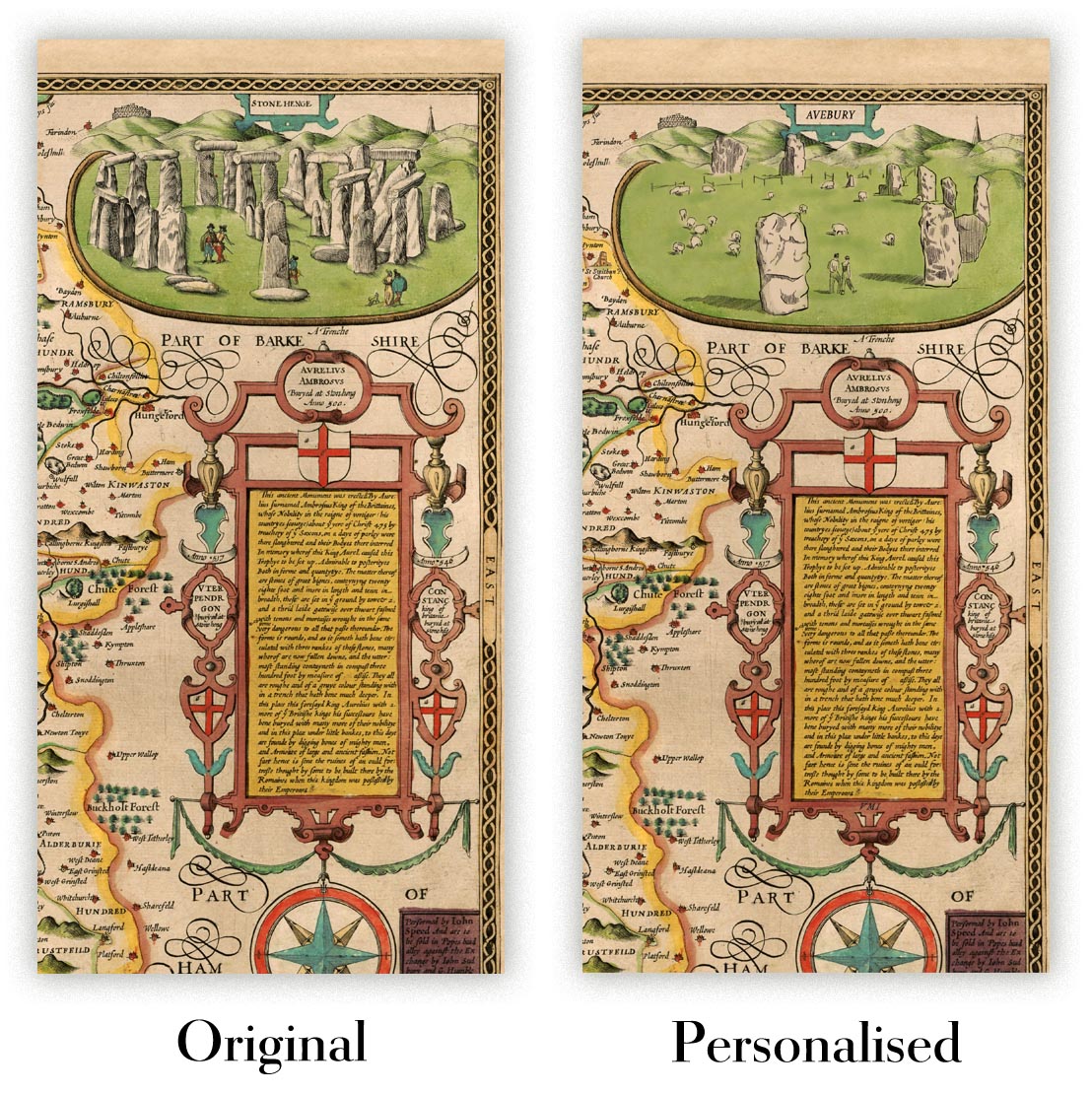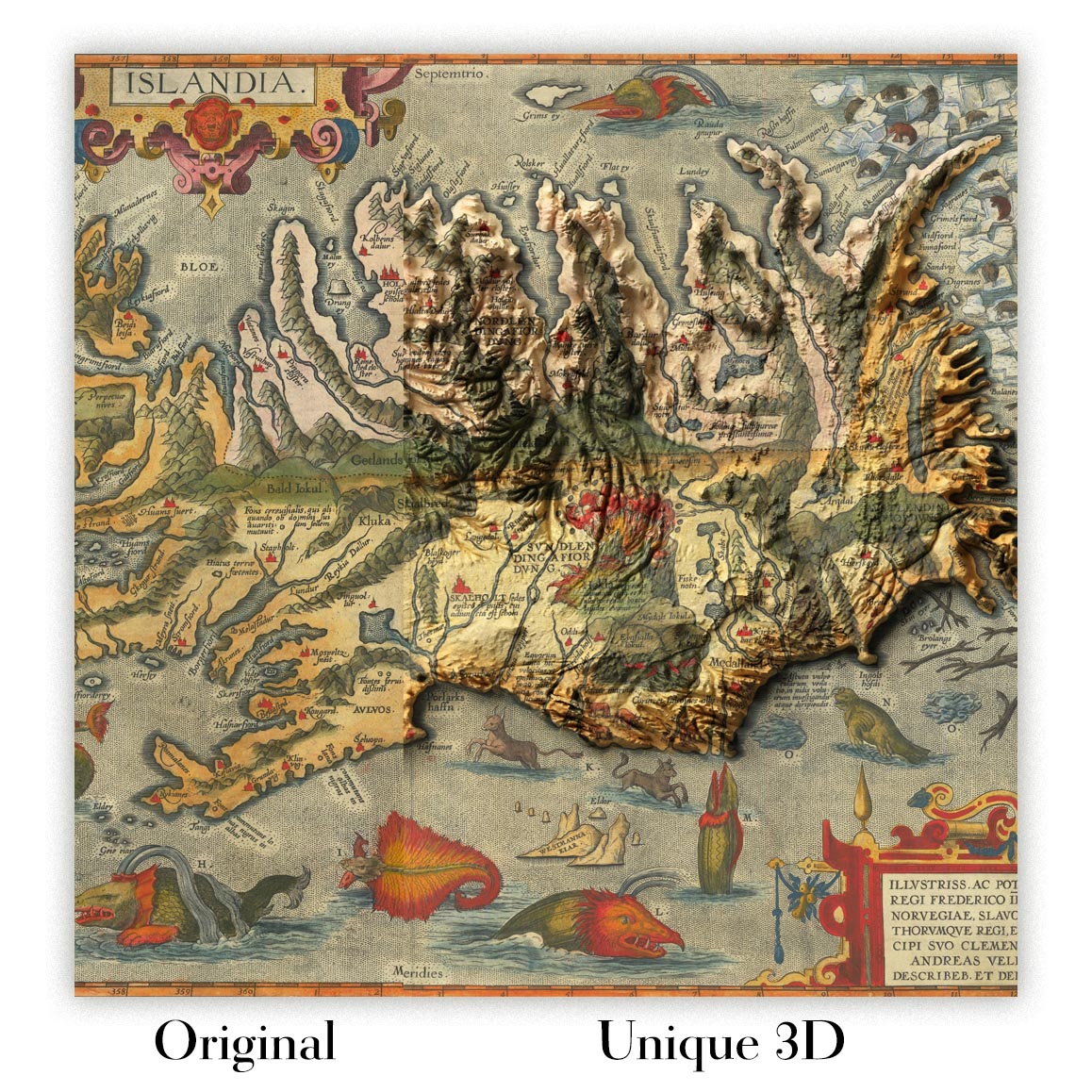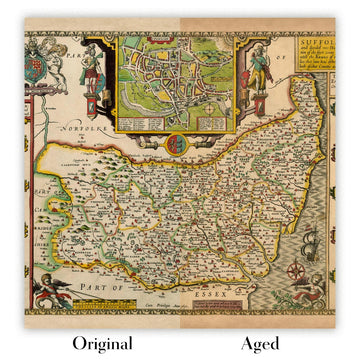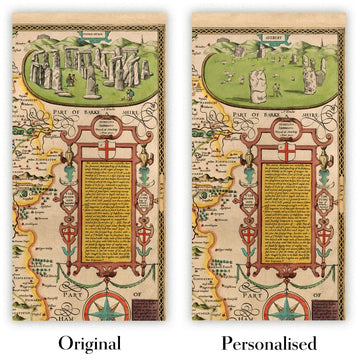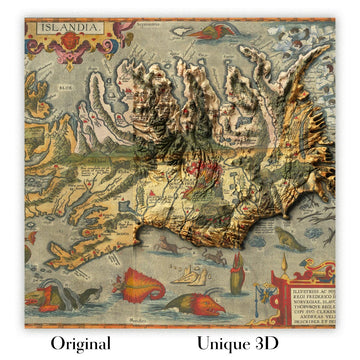- Handmade locally. No import duty or tax
- FREE worldwide delivery
- Love it or your money back (90 days)
- Questions? WhatsApp me any time
Own a piece of history
5,000+ 5 star reviews


"The Kingdome of Persia with the cheef citties and Habites described by John Speede" is a remarkable cartographic masterpiece that transports you to the heart of the Persian Empire as it was known in 1627. Crafted by the illustrious English cartographer John Speed, this map is a rare decorative gem from the first edition of Speed's Prospect of the most famous Parts of the World. The map not only delineates the political boundaries of Persia but also captures the rich cultural tapestry of the region with its detailed illustrations and vibrant colors.
John Speed, renowned for his meticulous and artistic approach to mapmaking, created this map during a time when European interest in the East was burgeoning. His work provides a fascinating Anglo-centric perspective on Persia, reflecting the European curiosity and the geopolitical dynamics of the early 17th century. Speed's maps are celebrated for their decorative elements, and this one is no exception, featuring intricate cartouches and vignettes that add a layer of visual allure to its historical and geographical accuracy.
The map is adorned with illustrations of four prominent towns: Spaha, Ormus, Tarvis, and Gilan, each depicted with a level of detail that brings the bustling life of these cities to the fore. The inclusion of eight figures in traditional Persian attire along the sides of the map offers a glimpse into the diverse cultural fabric of the region. These visual elements, combined with the rich textual descriptions on the verso, provide a comprehensive view of life in Persia during this period.
Geographically, the map is a treasure trove of information, showcasing the vast expanse of the Persian Empire and its neighboring regions. The Caspian Sea, labeled as the Sea of Bachu, the Persian Gulf, and the Indian Ocean are prominently featured, along with various mountain ranges and rivers that crisscross the landscape. The borders of the empire are meticulously drawn, highlighting its interactions with the Turkish Empire, Tartaria, and India, among others. This detailed representation underscores the strategic importance of Persia in the early modern world.
Historically, this map is significant not only for its cartographic precision but also for its cultural insights. It reflects the European fascination with Persia and provides a window into the geopolitical landscape of the time. The decorative elements, such as the ornate cartouches and the vibrant illustrations, enhance its appeal, making it a coveted piece for collectors and history enthusiasts alike. Owning this map is akin to holding a piece of history, a testament to the rich legacy of John Speed's cartographic prowess and the enduring allure of the Persian Empire.
Cities and towns on this map
- Persia (modern-day Iran):
- Tehran (Modern-day population: ~9 million)
- Isfahan (Modern-day population: ~2 million)
- Shiraz (Modern-day population: ~1.5 million)
- Tabriz (Modern-day population: ~1.6 million)
- Mashhad (Modern-day population: ~3 million)
- Qazvin (Modern-day population: ~400,000)
- Kerman (Modern-day population: ~800,000)
- Yazd (Modern-day population: ~530,000)
- Rasht (Modern-day population: ~700,000)
- Hamadan (Modern-day population: ~500,000)
- Kashan (Modern-day population: ~400,000)
- Qom (Modern-day population: ~1.2 million)
- Ahvaz (Modern-day population: ~1.3 million)
- Khorramabad (Modern-day population: ~400,000)
- Sanandaj (Modern-day population: ~500,000)
- Ardabil (Modern-day population: ~500,000)
- Turkey (part of the Turkish Empire):
- Erzurum (Modern-day population: ~760,000)
- India:
- Lahore (Modern-day population: ~11 million)
- Multan (Modern-day population: ~1.9 million)
- Kandahar (Modern-day population: ~614,000)
- Central Asia (Tartaria):
- Samarkand (Modern-day population: ~500,000)
- Bukhara (Modern-day population: ~270,000)
- Arabian Peninsula (Arabia Felix):
- Muscat (Modern-day population: ~1.4 million)
Notable Features & Landmarks
- Illustrations:
- Four town views: Spaha, Ormus, Tarvis, and Gilan.
- Eight figures in traditional garb on the sides.
- Landmarks:
- The Sea of Bachu (Caspian Sea)
- The Persian Gulf
- The Indian Sea
- Bodies of water:
- Caspian Sea
- Persian Gulf
- Indian Ocean
- Borders:
- Borders of the Persian Empire with neighboring regions.
- Mountains:
- Various mountain ranges depicted throughout the map.
- Other notable features:
- Decorative cartouches and ornate map title.
Historical and design context
- Name of the map: The Kingdome of Persia with the cheef citties and Habites described by John Speede
- Extra notes:
- Rare decorative map of the Persian Empire from the first edition of Speed's Prospect of the most famous Parts of the World.
- The text on the verso provides a colorful Anglo-centric view of life in Persia at the beginning of the 17th century.
- Date created: 1627
- Mapmaker or publisher: John Speed, a notable English cartographer and historian known for his detailed and decorative maps.
- Topics and themes:
- Political boundaries of the Persian Empire.
- Physical geography including mountains, rivers, and bodies of water.
- Cultural aspects depicted through illustrations of local attire.
- Countries and regions shown:
- Persia (modern-day Iran)
- Parts of the Turkish Empire (Ottoman Empire)
- Tartaria (Central Asia)
- India
- Arabia Felix (part of the Arabian Peninsula)
- Design or style:
- Decorative with detailed illustrations and vignettes.
- Richly colored and artistically rendered.
- Includes figures in traditional garb to provide cultural context.
- Historical significance:
- Reflects European views and knowledge of Persia in the early 17th century.
- Provides insights into the geographic and political understanding of the region during that period.
Please double check the images to make sure that a specific town or place is shown on this map. You can also get in touch and ask us to check the map for you.
This map looks great at every size, but I always recommend going for a larger size if you have space. That way you can easily make out all of the details.
This map looks amazing at sizes all the way up to 90in (230cm). If you are looking for a larger map, please get in touch.
The model in the listing images is holding the 16x20in (40x50cm) version of this map.
The fifth listing image shows an example of my map personalisation service.
If you’re looking for something slightly different, check out my collection of the best old maps to see if something else catches your eye.
Please contact me to check if a certain location, landmark or feature is shown on this map.
This would make a wonderful birthday, Christmas, Father's Day, work leaving, anniversary or housewarming gift for someone from the areas covered by this map.
This map is available as a giclée print on acid free archival matte paper, or you can buy it framed. The frame is a nice, simple black frame that suits most aesthetics. Please get in touch if you'd like a different frame colour or material. My frames are glazed with super-clear museum-grade acrylic (perspex/acrylite), which is significantly less reflective than glass, safer, and will always arrive in perfect condition.
This map is also available as a float framed canvas, sometimes known as a shadow gap framed canvas or canvas floater. The map is printed on artist's cotton canvas and then stretched over a handmade box frame. We then "float" the canvas inside a wooden frame, which is available in a range of colours (black, dark brown, oak, antique gold and white). This is a wonderful way to present a map without glazing in front. See some examples of float framed canvas maps and explore the differences between my different finishes.
For something truly unique, this map is also available in "Unique 3D", our trademarked process that dramatically transforms the map so that it has a wonderful sense of depth. We combine the original map with detailed topography and elevation data, so that mountains and the terrain really "pop". For more info and examples of 3D maps, check my Unique 3D page.
For most orders, delivery time is about 3 working days. Personalised and customised products take longer, as I have to do the personalisation and send it to you for approval, which usually takes 1 or 2 days.
Please note that very large framed orders usually take longer to make and deliver.
If you need your order to arrive by a certain date, please contact me before you order so that we can find the best way of making sure you get your order in time.
I print and frame maps and artwork in 23 countries around the world. This means your order will be made locally, which cuts down on delivery time and ensures that it won't be damaged during delivery. You'll never pay customs or import duty, and we'll put less CO2 into the air.
All of my maps and art prints are well packaged and sent in a rugged tube if unframed, or surrounded by foam if framed.
I try to send out all orders within 1 or 2 days of receiving your order, though some products (like face masks, mugs and tote bags) can take longer to make.
If you select Express Delivery at checkout your order we will prioritise your order and send it out by 1-day courier (Fedex, DHL, UPS, Parcelforce).
Next Day delivery is also available in some countries (US, UK, Singapore, UAE) but please try to order early in the day so that we can get it sent out on time.
My standard frame is a gallery style black ash hardwood frame. It is simple and quite modern looking. My standard frame is around 20mm (0.8in) wide.
I use super-clear acrylic (perspex/acrylite) for the frame glass. It's lighter and safer than glass - and it looks better, as the reflectivity is lower.
Six standard frame colours are available for free (black, dark brown, dark grey, oak, white and antique gold). Custom framing and mounting/matting is available if you're looking for something else.
Most maps, art and illustrations are also available as a framed canvas. We use matte (not shiny) cotton canvas, stretch it over a sustainably sourced box wood frame, and then 'float' the piece within a wood frame. The end result is quite beautiful, and there's no glazing to get in the way.
All frames are provided "ready to hang", with either a string or brackets on the back. Very large frames will have heavy duty hanging plates and/or a mounting baton. If you have any questions, please get in touch.
See some examples of my framed maps and framed canvas maps.
Alternatively, I can also supply old maps and artwork on canvas, foam board, cotton rag and other materials.
If you want to frame your map or artwork yourself, please read my size guide first.
My maps are extremely high quality reproductions of original maps.
I source original, rare maps from libraries, auction houses and private collections around the world, restore them at my London workshop, and then use specialist giclée inks and printers to create beautiful maps that look even better than the original.
My maps are printed on acid-free archival matte (not glossy) paper that feels very high quality and almost like card. In technical terms the paper weight/thickness is 10mil/200gsm. It's perfect for framing.
I print with Epson ultrachrome giclée UV fade resistant pigment inks - some of the best inks you can find.
I can also make maps on canvas, cotton rag and other exotic materials.
Learn more about The Unique Maps Co.
Map personalisation
If you're looking for the perfect anniversary or housewarming gift, I can personalise your map to make it truly unique. For example, I can add a short message, or highlight an important location, or add your family's coat of arms.
The options are almost infinite. Please see my map personalisation page for some wonderful examples of what's possible.
To order a personalised map, select "personalise your map" before adding it to your basket.
Get in touch if you're looking for more complex customisations and personalisations.
Map ageing
I have been asked hundreds of times over the years by customers if they could buy a map that looks even older.
Well, now you can, by selecting Aged before you add a map to your basket.
All the product photos you see on this page show the map in its Original form. This is what the map looks like today.
If you select Aged, I will age your map by hand, using a special and unique process developed through years of studying old maps, talking to researchers to understand the chemistry of aging paper, and of course... lots of practice!
If you're unsure, stick to the Original colour of the map. If you want something a bit darker and older looking, go for Aged.
If you are not happy with your order for any reason, contact me and I'll get it fixed ASAP, free of charge. Please see my returns and refund policy for more information.
I am very confident you will like your restored map or art print. I have been doing this since 1984. I'm a 5-star Etsy seller. I have sold tens of thousands of maps and art prints and have over 5,000 real 5-star reviews. My work has been featured in interior design magazines, on the BBC, and on the walls of dozens of 5-star hotels.
I use a unique process to restore maps and artwork that is massively time consuming and labour intensive. Hunting down the original maps and illustrations can take months. I use state of the art and eye-wateringly expensive technology to scan and restore them. As a result, I guarantee my maps and art prints are a cut above the rest. I stand by my products and will always make sure you're 100% happy with what you receive.
Almost all of my maps and art prints look amazing at large sizes (200cm, 6.5ft+) and I can frame and deliver them to you as well, via special oversized courier. Contact me to discuss your specific needs.
Or try searching for something!







